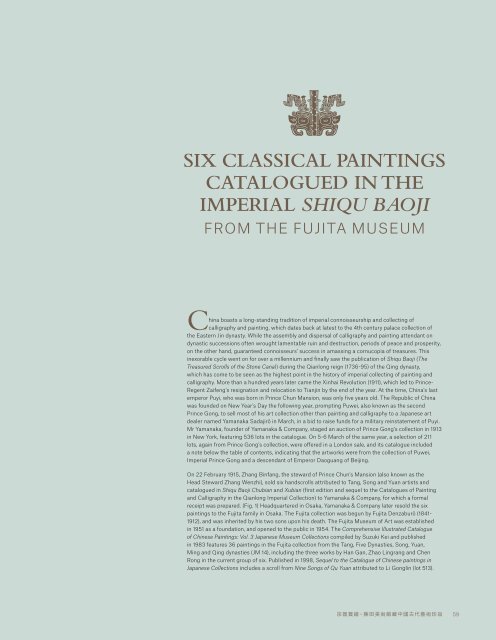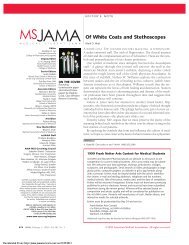SPECIALISTS AND SERVICES FOR THIS AUCTION
NYR14319_SaleCat
NYR14319_SaleCat
Create successful ePaper yourself
Turn your PDF publications into a flip-book with our unique Google optimized e-Paper software.
SIX CLASSICAL PAINTINGS<br />
CATALOGUED IN THE<br />
IMPERIAL SHIQU BAOJI<br />
FROM THE FUJITA MUSEUM<br />
China boasts a long-standing tradition of imperial connoisseurship and collecting of<br />
calligraphy and painting, which dates back at latest to the 4th century palace collection of<br />
the Eastern Jin dynasty. While the assembly and dispersal of calligraphy and painting attendant on<br />
dynastic successions often wrought lamentable ruin and destruction, periods of peace and prosperity,<br />
on the other hand, guaranteed connoisseurs’ success in amassing a cornucopia of treasures. This<br />
inexorable cycle went on for over a millennium and fnally saw the publication of Shiqu Baoji (The<br />
Treasured Scrolls of the Stone Canal) during the Qianlong reign (1736-95) of the Qing dynasty,<br />
which has come to be seen as the highest point in the history of imperial collecting of painting and<br />
calligraphy. More than a hundred years later came the Xinhai Revolution (1911), which led to Prince-<br />
Regent Zaifeng’s resignation and relocation to Tianjin by the end of the year. At the time, China’s last<br />
emperor Puyi, who was born in Prince Chun Mansion, was only fve years old. The Republic of China<br />
was founded on New Year’s Day the following year, prompting Puwei, also known as the second<br />
Prince Gong, to sell most of his art collection other than painting and calligraphy to a Japanese art<br />
dealer named Yamanaka Sadajirō in March, in a bid to raise funds for a military reinstatement of Puyi.<br />
Mr Yamanaka, founder of Yamanaka & Company, staged an auction of Prince Gong’s collection in 1913<br />
in New York, featuring 536 lots in the catalogue. On 5-6 March of the same year, a selection of 211<br />
lots, again from Prince Gong’s collection, were ofered in a London sale, and its catalogue included<br />
a note below the table of contents, indicating that the artworks were from the collection of Puwei,<br />
Imperial Prince Gong and a descendant of Emperor Daoguang of Beijing.<br />
On 22 February 1915, Zhang Binfang, the steward of Prince Chun’s Mansion (also known as the<br />
Head Steward Zhang Wenzhi), sold six handscrolls attributed to Tang, Song and Yuan artists and<br />
catalogued in Shiqu Baoji Chubian and Xubian (frst edition and sequel to the Catalogues of Painting<br />
and Calligraphy in the Qianlong Imperial Collection) to Yamanaka & Company, for which a formal<br />
receipt was prepared. (Fig. 1) Headquartered in Osaka, Yamanaka & Company later resold the six<br />
paintings to the Fujita family in Osaka. The Fujita collection was begun by Fujita Denzaburō (1841-<br />
1912), and was inherited by his two sons upon his death. The Fujita Museum of Art was established<br />
in 1951 as a foundation, and opened to the public in 1954. The Comprehensive Illustrated Catalogue<br />
of Chinese Paintings: Vol. 3 Japanese Museum Collections compiled by Suzuki Kei and published<br />
in 1983 features 36 paintings in the Fujita collection from the Tang, Five Dynasties, Song, Yuan,<br />
Ming and Qing dynasties (JM 14), including the three works by Han Gan, Zhao Lingrang and Chen<br />
Rong in the current group of six. Published in 1998, Sequel to the Catalogue of Chinese paintings in<br />
Japanese Collections includes a scroll from Nine Songs of Qu Yuan attributed to Li Gonglin (lot 513).<br />
59



